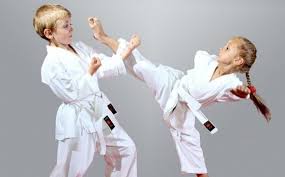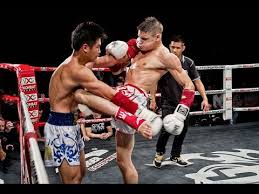KARATE
 KARATE, karate-do, a kind of Japanese martial art, a system of defense and attack without weapons. Unlike other martial arts in Japan (sumo, ju-jitsu, judo, aikido), which involve wrestling, holding various kinds of throws, holding captures and asphyxiation techniques, in karate the degree of direct contact between the participants of the fight is minimal, and precisely targeted ones are used to crush the enemy powerful blows with hands or feet applied to vital points of his body.
KARATE, karate-do, a kind of Japanese martial art, a system of defense and attack without weapons. Unlike other martial arts in Japan (sumo, ju-jitsu, judo, aikido), which involve wrestling, holding various kinds of throws, holding captures and asphyxiation techniques, in karate the degree of direct contact between the participants of the fight is minimal, and precisely targeted ones are used to crush the enemy powerful blows with hands or feet applied to vital points of his body.
At the initial stage, karate was a system of hand-to-hand combat, intended exclusively for self-defense. Today karate has become much more famous thanks to the demonstration performances demonstrating the power of a karate kick. So, experienced karate masters can chop a block of ice with their fists, smash a 15 cm thick pine wood chip into a chip, break them with an elbow or head into a pile of roofing tiles.
HISTORY REFERENCE.
Karate – in the original translation “Chinese hand” – how the system developed on the island of Okinawa (Ryukyu archipelago) in the 14-18 centuries. based on the technique of Chinese boxing Quan-fa (“teaching the fist”) – one of the Chinese martial arts. On Okinawa twice during the period of 14-17 centuries. a state ban was introduced on the carrying and storage of weapons. Violation of the ban was severely punished. This situation forced the population of the island to seek means of self-defense without weapons, and acquaintance with Quan-fa made it possible to develop their own battle system, which made it possible for an unarmed person to confront an armed enemy on equal terms.
Subsequently, the character “Kara” – “Chinese” was changed to a similarly sounding, but having a different meaning, the character “Kara” – “empty”. Gitin Funakoshi (1868–1957), a well-known master and popularizer of karate, explained the meaning of this replacement: “As the polished surface of the mirror reflects everything in front of him, and the quiet valley carries the slightest sound, so the karate student must free himself from selfishness and anger, trying to adequately respond to everything that he may encounter. This is the meaning of the hieroglyph “empty.” ”Later, the concept of“ before ”-“ road ”appeared, in philosophical understanding the path, direction, life position of a fighter, the essence of which is the constant improvement of body and spirit.
At the beginning of the 20th century Karate art went beyond the borders of Okinawa’s clan family schools and quickly conquered all of Japan, which was greatly facilitated by the vibrant activity of Funakoshi, who lectured at universities, organized karate study groups, and demonstrated his techniques. In 1936, Funakoshi opened a school called Shotokan (“house of pines and waves”), where he began to teach a style named after the school. Over time, the Shotokan style became the classic karate style. It is characterized by low stances, short and sharp hits, but rather quick and accurate than strong ones. The movement of the hips is the key to the correct implementation of all techniques. The defensive movement is also a counterattack.
In parallel with the development of the Shotokan style, other karate styles were formed, the main of which were Shito-ryu, Goju-ryu and Vado-ryu. The Shito-ryu style was created in the mid-1930s by the master Kenwa Mabuni (1893–1957). In this style, much attention is paid to the thoroughness of the implementation of techniques. An important role is also played by the speed and advancing of the enemy, both in attack and in defense. The Goju-ryu style (“strength and softness”) was founded by the master Chojun Miyagi (1888–1953). Being a physically very strong person, Miyagi in his style made the main emphasis on power and rigidity. Characteristic features of the style are high struts, slow, “heavy” movements, powerful break-through blows. Hironoro Otsuka (1892–1982) created the Vado-ryu style (“the way of the world”). Unlike the previous ones, this style is purely Japanese. The influence of Chinese and Okinawan techniques in it is almost imperceptible, and a number of tricks are borrowed from jujitsu. The bet here is on dexterity. The style uses deceptive movements and cares instead of straightforwardness and rigidity.
After the military defeat of Japan in 1945, the American occupation authorities banned all Japanese martial arts with the exception of karate, which was considered just a kind of Chinese gymnastics. In 1948, the Japanese Karate Association (JKA) was created, headed by Funakoshi, bringing together leading experts in this type of martial arts. Since that time, karate began to develop as a system of self-defense, and as a sport. Over time, karate has become increasingly popular throughout the world.
Currently, there are a huge number of organizations and federations of karate, combining various areas and styles. The largest international organizations are: JKA / WF (Japan Karate Association / World Federation), WKC (World Karate Confederation), WUKO (World Karate Union), WKF (World Karate Federation) and many others.




